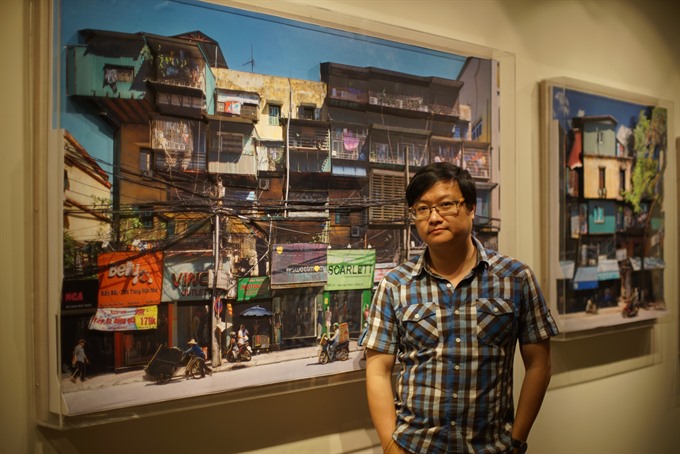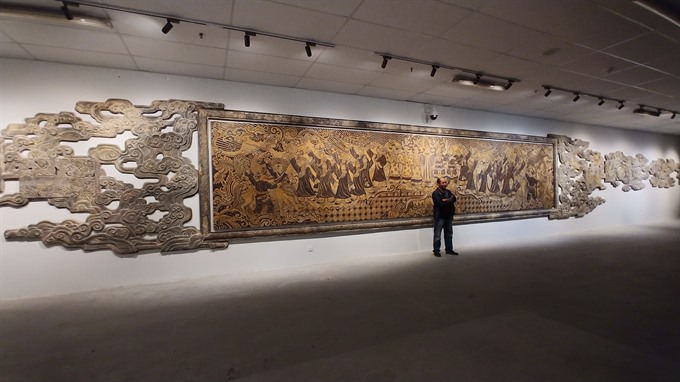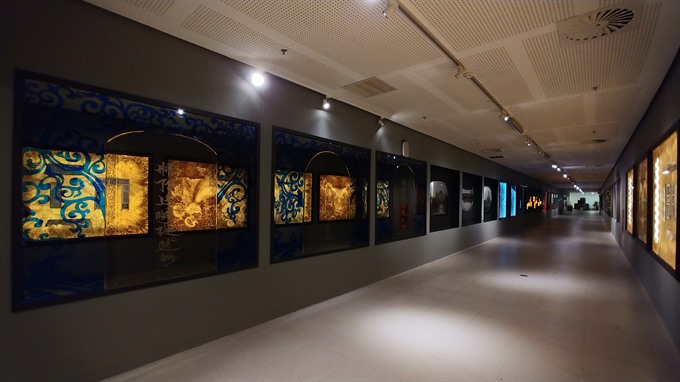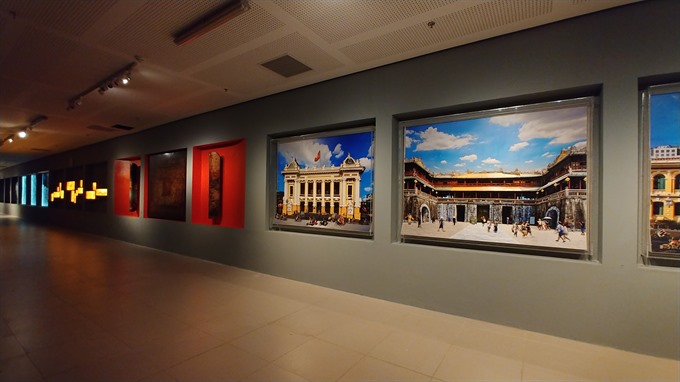 |
| Visionary: Artist and Artistic Curator Nguyen The Son in his studio in Ha Noi. Photos courtesy Nguyen The Son |
Viet Nam News
by George Burchett *
I was recently part of a group invited to preview the new contemporary art installation in the National Assembly building, on Ba Dinh Square, in Ha Noi.
Although I am reasonably familiar with contemporary art in Viet Nam, I really didn’t know what to expect. Public commissions usually tend towards conservatism, and one wouldn’t expect Viet Nam’s National Assembly to be any different. On the contrary, one would expect even more "conservatism" – whichever way one may define the term: politically, aesthetically and so on.
The Art Project in the Basement of National Assembly House – its current title – was presented to the visiting group by artist Nguyen The Son, the project’s artistic curator and one of the participating artists. Son is a well established artist, in Viet Nam and internationally. He is best known for his photo-montages of Ha Noi streets, which, apart from their artistic merits, are also a valuable record of the fast-changing capital of fast-developing Viet Nam.
The 14 other artists who worked on the project are:
Phan Hai Bang, Nguyen Xuan Lam, Vuong Van Thao, Vu Xuan Dong, Can Van An, Pham Khac Quang, Tran Cong Dung, Trieu Khac Tien, Trieu Minh Hai, Oanh Phi Phi, Vu Kim Thu,Le Dang Ninh, Trinh Minh Tien, and Tran Hau Yen The.
And the result of their individual and collective efforts is no less than spectacular!
 |
| Huge piece: An man poses for a photo in front of art by Vu Xuan Dong and Pham Khac Quang in the car park. |
I have been living permanently in Ha Noi for almost eight years and have been actively involved with Vietnamese art and artists, but I have never seen anything like the art collection on display in the National Assembly Building. Hanoians and visitors to the city are used to seeing Vietnamese contemporary art in a few spaces like Manzi, the Goethe Institute, L’Espace, Heritage Space, Art Viet Nam Gallery and a few other artist-run spaces and collectives. The physical space is usually limited, which in turn limits the scope of what the artists can convey and the public absorb.
In the National Assembly Building, the artists collective was given “over 500 metres within three areas of the National Assembly’s basement” to produce works that would decorate the bland corridors – through which staff enter the building – and car park. And they were given only three months to conceptualise, design, produce and install the works themselves.
I asked artist and curator Son: "How did you do it?"
"Mrs Nguyen Thi Kim Ngan, chairwoman of the National Assembly saw my public art project in Phung Hung and was impressed. She contacted me and invited me to present ideas for art in the National Assembly Building. I made a 30-minute Power-Point presentation. The leaders liked it and gave me the green light and only three months to complete the project, Son said.
“I assembled a team of artists according to their expertise and their ability to produce the works in such a short time. They had to drop everything and totally commit themselves to the project."
I told Son that apart from being stunning on their own, the works actively communicate with each other, talk to each other and to the viewer, which is also an amazing achievement. How did that happen?
"There was a great spirit of camaraderie within our team. We regularly got together to discuss the progress of the works and shared ideas. And all the artists were moved and inspired by the archaeological collection in the Thang Long Archaeological Museum, situated on two levels under the National Assembly Building. So there was also a dialogue between the artists working on the National Assembly project and Viet Nam’s distant past, inspiring the artists and connecting them through time and space," Son said.
 |
| Contemporary style: Works by Tran Hau Yen The. |
 |
| Collection: Art works by Nguyen The Son and Oanh Phi Phi. |
So how did the leadership of the National Assembly react to the finished result of that artistic collaboration?
"They loved it so much that they decided to open the collection in the basement to the public and link it to the new Thang Long Museum. They also decided to move their car park elsewhere in the building and open the car park section with our art to the general public."
The Thang Long Museum and the National Assembly’s collection of contemporary Vietnamese art will open to the public some time after the Lunar New Year.
Ha Noi is in for a very special treat in 2019, the Year of the Pig: a stunning contemporary art collection and a new museum that connect Viet Nam’s ancient history to its current dynamic reality.
And we can be sure that once it is open to the public, the art and archaeological artefacts in the underground of the National Assembly will also inspire and inform how the nation’s capital, Ha Noi, develops above ground – for the better, one hopes!
We must be grateful to the National Assembly leadership, artist and curator Son and his team of exceptional artists from Ha Noi, Thai Binh and Hue, for having the vision, talents and skills to make this wonderful contribution to Ha Noi’s and Viet Nam’s culture, arts and history, for their achievement of directly linking the contemporary Vietnamese art to its ancestral roots. And for setting a very inspiring example of creative collaboration for all to follow.
Be ready for a very special artistic and cultural event in the New Year! Soon you’ll be able to see the art in the National Assembly Building -- contemporary and ancient – and judge it for yourselves. — VNS
*George Burchett is an artist who was born and lives in Ha Noi.
OVietnam